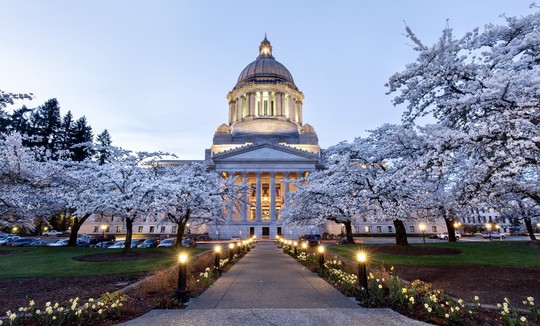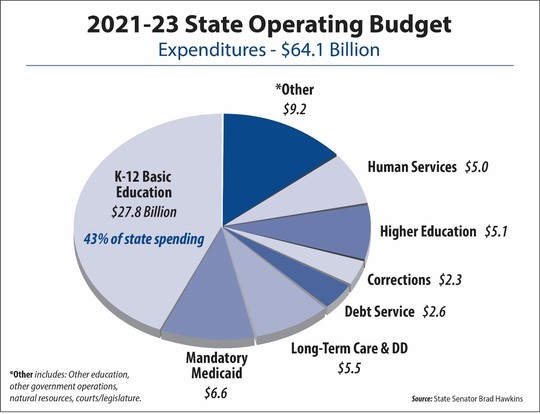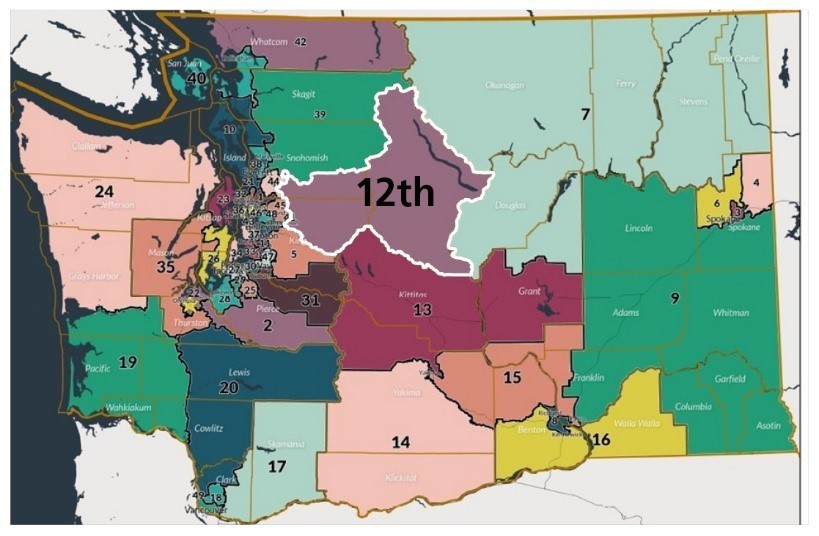December 27, 2022
Dear Friends and Neighbors,
The Washington State Legislature meets annually each January but alternates between longer sessions of 105 days when developing the state’s two-year budgets in odd years and shorter sessions of 60 days in even years. This year, the Legislature will convene on January 9 for a 105-day session. The primary focus of the session will be developing the operating, transportation, and capital budgets for the 2023-2025 biennium (July 1, 2023 - June 30, 2025). In addition to developing new state budgets, committees will conduct hearings and the Legislature will debate and update various laws. After two years of COVID pandemic “hybrid” sessions involving a mixture of in-person and remote voting, the upcoming session is expected to be mostly a return to normal in terms of operations.
 The Washington State Legislature will convene in Olympia on January 9 to begin its 105-day session. In addition to operating, transportation, and capital budget updates, committees will conduct hearings and the Legislature will debate and update various laws.
Operating budget ($64.1 billion for 2021-2023)
The operating budget ($64.1 billion) funds the day-to-day operations of the state for two years, including early learning, K-12 education, higher education, health and human services, criminal justice, natural resources, courts, and other areas. Despite the COVID pandemic, state revenues have been healthy and positive, with more dollars flowing into the state than what was projected earlier in the pandemic. The November revenue forecasts estimates $66.2 billion for the 2023-2025 budget cycle. It remains uncertain how economic factors, such as federal interest rates, gas prices, home values, and past inflation will affect state revenues over the next two years. I have concerns about the sustainability of the overall state budget if future revenues decline. It is my preference that the state set aside more funding in its reserve account to weather any reduced revenue situations. More robust state reserves would help mitigate against any tax increases or spending reductions. For more information about the operating budget, click here.
 |
The 2021-23 operating budget of $64.1 billion funds the day-to-day operations of state government for the two-year period ending Jun 30, 2023. When legislators convene in January 9, 2023, they will begin developing a budget for 2023-25.
Transportation budget ($12.2 billion for 2021-2023)
The transportation budget funds the construction and maintenance of the state transportation system, including the maintenance and preservation of roads, bridges, and ferries. This budget also funds the state agencies and commissions that serve our transportation system, including the Washington State Patrol, Department of Licensing, Department of Transportation, Washington Traffic Safety Commission, County Road Administration Board, Transportation Improvement Board, Transportation Commission, and Freight Mobility Strategic Investment Board. The budget also funds numerous previously approved road projects based on their construction schedules. Due to the lack of driving during the COVID pandemic, much of the gas tax and other revenues that the transportation budget depends upon were significantly less than in past years, but infrastructure support was provided to states through recent federal legislation. During the 2022 legislative session, the Legislature approved a new 16-year, $16.9 billion “Move Ahead Washington” transportation investment package, primarily for preservation and maintenance of the existing system and to complete large-scale transportation projects. (This is separate from the supplemental transportation budget but factors into future spending plans). The plan combines federal infrastructure funds, climate revenues approved during a previous session, transfers from the operating budget, and license plate and driver license fees to fund a collection of new investments. For more information about the additional 16-year Move Ahead Washington investments or the $12.2 billion transportation budget for 2021-23, click here.
 Due to the COVID pandemic, the Capitol Building in Olympia has been mostly empty during the past two legislative sessions. This is expected to change for the upcoming 2023 session with most activities returning to more standard operations.
Capital budget ($7.8 billion for 2021-2023)
The state capital budget funds the construction and maintenance of state buildings, public school matching grants, higher education facilities, public lands, parks, and other assets. Most sections of the capital budget include grant programs where local governments apply for funding based on specific qualifications and submission of matching funds. Other elements of the capital budget are more subjective. In recent years, the 12th District team has been able to generate big wins for our district through this budget, including the replacement of key infrastructure following tragic wildfires, the expansion of outdoor recreation opportunities that improve our economy and quality of life, and enhancements to key community response systems. Our legislative team will be evaluating the various requests submitted to the Legislature when developing the 2023-25 capital budget. However, the next capital budget could be significantly strained due to the rising costs and inflationary factors associated with public works project in recent years. For more information about the final capital budget, click here.
Legislators representing their new districts
The Washington State Redistricting Commission’s new boundaries for our 49 legislative districts are in effect for the 2023 Legislative session. The redistricting process is completed every 10 years to balance the population among districts. The new boundary for the 12th District includes East Wenatchee, Chelan County, and portions of Snohomish County (Index to Monroe) and King County (North Bend to Duvall). The 12th District had perhaps the most significant change as its boundaries now cross the Cascade Mountains. In addition to 12th District, many other boundaries have also been adjusted and some districts have new legislators resulting from past retirements and recent elections. The 2023 Legislature will consist of 49 members of the State Senate (29 Democrats and 20 Republicans) and 98 members of the House of Representatives (58 Democrats and 40 Republicans) with many new members. It will be interesting to see how the Legislature functions with lawmakers representing their new districts.
 Washington state has 49 different legislative districts, which are balanced every 10 years based on population. Each district is represented by one state senator and two state representatives.
Thank you for the opportunity to serve as your state senator.
Sincerely,
 Brad Hawkins
State Senator Brad Hawkins
12th Legislative District
Website: senatorbradhawkins.org
107 Newhouse Building - P.O. Box 40412 | Olympia, WA 98504-0412
(360) 786-7622 or Toll-free: (800) 562-6000
|